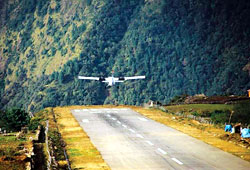 Air accidents don't have a season. They can, and do, occur just about anytime and anyplace. In Nepal though, most air crashes over the last 15 years have occurred in the rainy season.
Air accidents don't have a season. They can, and do, occur just about anytime and anyplace. In Nepal though, most air crashes over the last 15 years have occurred in the rainy season.
Recall the disasters of 1992 when a Thai jet and a PIA jet crashed into the mountains surrounding Kathmandu during the monsoon, killing all onboard. Or the RNAC crash in July 2000 near Dhangadhi that killed 25 people. Or the Shangri-La Air Twin Otter crash of August 2002 which took 18 lives. Or the May 2004 Yeti Air accident in Lukla in which three crew members died. The list goes on and on.
Now add to that last month's helicopter crash in Taplejung, which snuffed out 24 lives. All the new-fangled technology such as GPS, GWPS, EGWPS, with which the copter was reportedly equipped could not save it from slamming into the mountainside.
The immediate lesson of the Taplejung crash is this: no technology can rule out disasters in poor weather conditions, especially in the Himalayas. It can minimise the frequency of crashes, but not stop them. In some cases, technology actually contributes to accidents by giving rise to a false sense of security.
After covering aviation and air disasters in Nepal for over a decade, I have a simple rule: don't fly in the monsoon, especially in the mountains. It's not worth the risk. Go by bus or pony, hike, trek, or postpone your program. The litany of air crashes in the monsoon is now too long to be a fluke.
It's true that improved technology and navigational aids have made all-weather flying routine in Nepal, bringing once remote and cut-off destinations into contact with the outside world. But the number of flights have also led to an increase in the accident rate.
The official investigation committee looking into the Taplejung crash will probably find the reasons for the disaster, but we may never know what led the pilot to fly in such bad weather. What led him to take risks on a day when most other pilots would have called the flight off? "I wouldn't have flown in that weather," one pilot told me recently, with the benefit of hindsight.
Was the Shree Air crew under corporate pressure to return to Kathmandu? Did the pilot come under inadvertent pressure to fly from some of the illustrious passengers? Or was the pilot foolhardy enough to want to test his skills in zero visibility conditions? If any meaningful lessons are to come out from this disaster, figuring out what motivated the pilot's decision is essential.
The probe committee should look into the role of technology. If the chopper was indeed equipped with all the latest gizmos, did it lull the pilots into a false sense of security?
Technology can do wonders, but it also encourages flyers to take unnecessary risks. At the very least, pilots get so used to it that they sometimes ignore the obvious. Both the 1992 crashes resulted from human errors stemming from a momentary inability to correctly read or calibrate crucial flight instruments. These shortcomings convinced the Japan government to install radar at TIA airport, primarily to verify the altitude, location and direction reported by pilots.
The committee should also focus on interpersonal relationships between the cockpit crew. According to one domestic airline pilot, cockpit communications in Nepal is poor because the pilot in command usually ignores advice from the junior pilot. "We are all required to undergo Cockpit Resource Management training aimed at building good communications in the cockpit, but its lessons are quickly forgotten," says the pilot.
Did the Shree Air co-pilot or navigator issue any warnings to the pilot before taking off? And if so, why did the pilot ignore these warnings?
In January 1995 an RNAC Twin Otter plunged right off the runway's northern edge in Kathmandu, killing the pilot and several passengers. It was later discovered that both the pilots were of similar rank. As the plane was rolling on the runway, the co-pilot had wanted to abort the take-off but the pilot continued with it anyway. The confusion resulted in the crash.



